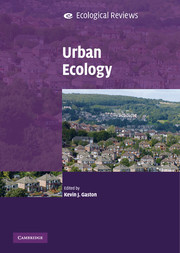Book contents
- Frontmatter
- Contents
- List of contributors
- Preface
- 1 Urban ecology
- 2 Urbanisation
- 3 Urban environments and ecosystem functions
- 4 Individual species and urbanisation
- 5 Species diversity and urbanisation: patterns, drivers and implications
- 6 Urbanisation and alien invasion
- 7 Interactions between people and nature in urban environments
- 8 Urban ecology and human social organisation
- 9 Urban ecology and human health and wellbeing
- 10 Bringing cities alive: the importance of urban green spaces for people and biodiversity
- 11 Integrating nature values in urban planning and design
- 12 Urban futures
- Index
- References
12 - Urban futures
Published online by Cambridge University Press: 05 June 2012
- Frontmatter
- Contents
- List of contributors
- Preface
- 1 Urban ecology
- 2 Urbanisation
- 3 Urban environments and ecosystem functions
- 4 Individual species and urbanisation
- 5 Species diversity and urbanisation: patterns, drivers and implications
- 6 Urbanisation and alien invasion
- 7 Interactions between people and nature in urban environments
- 8 Urban ecology and human social organisation
- 9 Urban ecology and human health and wellbeing
- 10 Bringing cities alive: the importance of urban green spaces for people and biodiversity
- 11 Integrating nature values in urban planning and design
- 12 Urban futures
- Index
- References
Summary
In this chapter, I review some of the extensive literature on urbanisation to examine the future of urban growth and its impact on the biosphere. I argue that the relatively few ecological studies on urbanisation thus far have typically focused on the environmental impact of cities at local spatial scales when we also need to consider urban impacts at regional and global scales. By expanding our view of urban impacts beyond describing local environmental impacts, it becomes clear that cities can provide opportunities for biological conservation at many spatial scales. For example, cities concentrate human populations and produce economies of scale that can reduce per capita human impact on the atmosphere and on regional watersheds, as well as on local air quality. A ‘sustainable’ city is thus not just a city that sustains its own existence. Rather it is a city that contributes to the long-term persistence of the biosphere and indeed the global environment (McGranahan & Satterthwaite 2003). Ecologists should therefore find and recommend ways that urban impacts can be reduced on regional and global scales as well as the local scale. To that end, this chapter devotes considerable discussion on ways to create more sustainable cities.
The future growth of cities
The proportion of humanity living in urban areas has consistently increased in recent decades, from just 10% in 1900 to 50% in 2007. Put another way, the twentieth century witnessed a ten-fold increase in urban populations.
- Type
- Chapter
- Information
- Urban Ecology , pp. 287 - 308Publisher: Cambridge University PressPrint publication year: 2010
References
- 5
- Cited by



